
- •Contents
- •Foreword
- •How to use this book
- •Advisory boards
- •Contributing writers
- •Contributing illustrators
- •What is an insect?
- •Evolution and systematics
- •Structure and function
- •Life history and reproduction
- •Ecology
- •Distribution and biogeography
- •Behavior
- •Social insects
- •Insects and humans
- •Conservation
- •Protura
- •Species accounts
- •Collembola
- •Species accounts
- •Diplura
- •Species accounts
- •Microcoryphia
- •Species accounts
- •Thysanura
- •Species accounts
- •Ephemeroptera
- •Species accounts
- •Odonata
- •Species accounts
- •Plecoptera
- •Species accounts
- •Blattodea
- •Species accounts
- •Isoptera
- •Species accounts
- •Mantodea
- •Species accounts
- •Grylloblattodea
- •Species accounts
- •Dermaptera
- •Species accounts
- •Orthoptera
- •Species accounts
- •Mantophasmatodea
- •Phasmida
- •Species accounts
- •Embioptera
- •Species accounts
- •Zoraptera
- •Species accounts
- •Psocoptera
- •Species accounts
- •Phthiraptera
- •Species accounts
- •Hemiptera
- •Species accounts
- •Thysanoptera
- •Species accounts
- •Megaloptera
- •Species accounts
- •Raphidioptera
- •Species accounts
- •Neuroptera
- •Species accounts
- •Coleoptera
- •Species accounts
- •Strepsiptera
- •Species accounts
- •Mecoptera
- •Species accounts
- •Siphonaptera
- •Species accounts
- •Diptera
- •Species accounts
- •Trichoptera
- •Species accounts
- •Lepidoptera
- •Species accounts
- •Hymenoptera
- •Species accounts
- •For further reading
- •Organizations
- •Contributors to the first edition
- •Glossary
- •Insects family list
- •A brief geologic history of animal life
- •Index
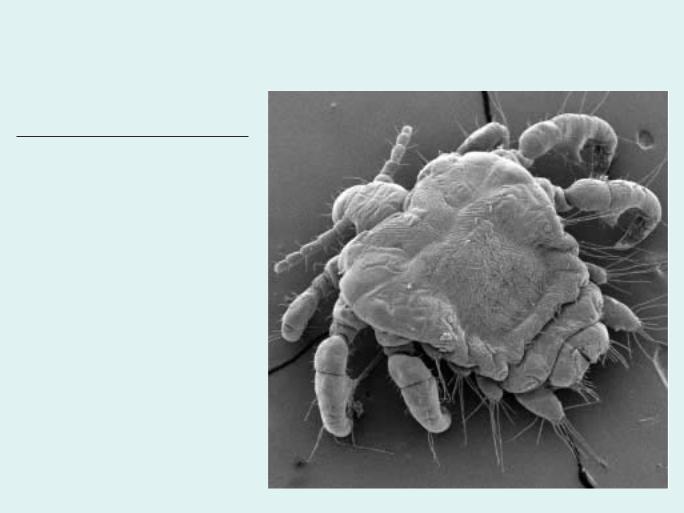
●
Phthiraptera
(Chewing and sucking lice)
Class Insecta
Order Phthiraptera
Number of families 24
Photo: Scanning electron micrograph of a female pubic or crab louse (Pthirus pubis). The short crablike body form and oversized claws are an adaptation to the coarse, thick hairs present in the pubic and perianal region of its human hosts. (Image by Vince Smith. Reproduced by permission.)
Evolution and systematics
It generally is accepted that lice (Phthiraptera) are derived from the insect order Psocoptera (the so-called book lice or bark lice), and speculative estimates place their origin between the Late Carboniferous and the end of the Cretaceous, 66–320 million years ago. With the exception of a louse egg found in Baltic amber and a louselike insect from the Lower Cretaceous of Transbaikalia in Russia, there are no fossils that might provide direct information on the evolution of lice. The host distribution of lice is, however, analogous in some ways to a fossil record.
The order Phthiraptera comprises four suborders, three of which (the Amblycera, Ischnocera, and Rhynchophthirina) are known as chewing or biting lice and the fourth (the Anoplura) as sucking lice. All species of Anoplura and Rhynchophthirina are restricted to mammals, whereas species of Ischnocera and Amblycera are known from both mammals and birds. Sucking lice and the so-called elephant and warthog lice (suborder Rhynchophthirina) are one another’s closest relatives and share more derived morphological features. These have a common ancestor with the Ischnocera and together form a sister taxon to the most basal louse suborder— the Amblycera.
By 1999, 4,384 valid species of chewing lice had been recorded from 3,910 different hosts (3,508 bird and 402 mammal species). The sucking lice are a much smaller group and, as of the year 2002, 543 valid species were described from 812 different species of mammals. These figures are a small fraction of the true species diversity among lice, and many new species await formal description or discovery.
Physical characteristics
Lice are wingless, typically flat-bodied insects with three to five short, segmented antennae, highly modified mouthparts, and six relatively short legs modified for clinging to their host’s feathers or pelage. Their size ranges from just 0.01 in (0.3 mm) long for the nymphs of some Hoplopleura (Anoplura) species on rodents, to 0.4 in (11 mm) for the giant adults of Laemobothrion (Amblycera) from birds of prey. Within many host groups there is a strong correlation between the size of the host and the size of their lice. Sexual dimorphism also influences louse size and is evident in many species, with females typically 10–20% larger than males.
The body is dorsoventrally flattened, with a horizontally positioned head. These are adaptations for lying flat against
Grzimek’s Animal Life Encyclopedia |
249 |
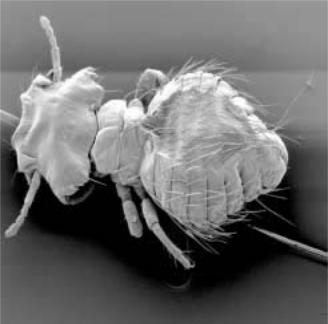
Order: Phthiraptera
Scanning electron micrograph of a lemur louse (Trichophilopterus babakotophilus) attached to a single hair shaft from a Madagascan lemur (Propithecus verreauxi). (Image by Vince Smith. Reproduced by permission.)
a hair shaft or between feather barbules, and they reduce the chance of the louse becoming dislodged during grooming or preening by the host. Coloration varies from pale white through shades of yellow and brown to black. Patterns are evident on some species, and cryptic coloration sometimes is employed, allowing the louse to match the coloration of its host’s plumage or pelage.
Lice have mandibles that have been variously modified in each of the suborders. Asymmetric opposing mandibles are present in Amblycera and Ischnocera. In Amblycera, the mandibles articulate horizontally from the head, whereas in Ischnocera, the mandibles articulate vertically. These mandibles are involved in feeding and play a vital secondary role in anchoring the louse to the host. Within the Rhynchophthirina, the mandibles are much reduced, occurring at the end of a long rostrum and articulating outward rather than opposing each other. In most Anoplura, the mandibles have been completely lost. However, some species have tiny mandibular vestiges present internally within the anterior section of the head. These vestiges are just one of the many characters that highlight the common ancestry of chewing and sucking lice.
Distribution
As permanent, obligate (host-specific) ectoparasites, lice have distributions that essentially mirror those of their hosts, with very few exceptions. As such, they are found worldwide and are present on every continent and in virtually every habitat occupied by birds and mammals. All orders and most families of birds have records of host-specific lice; of the few groups that do not, it is likely either that their lice are extinct
Vol. 3: Insects
or that the hosts have been searched insufficiently. Similarly, all major groups of mammals have lice, with the exception of species belonging to the orders Chiroptera (bats), Cetacea (whales and dolphins), Microbiotheria (Chilean colocolos), Monotremata (echidna and platypus), Notoryctemorphia (marsupial moles), Pholidota (pangolins), and Sirenia (dugongs and manatees).
Within the range of a host species, louse distribution often is patchy, and not every individual harbors all the lice previously recorded from the host. A true geographic distribution within the range of a host also has been noted for some species of lice. The size of a louse population varies enormously on different individuals, sometimes seasonally. Sick animals and, in particular, birds with damaged bills or feet may have abnormally large numbers, owing to their inability to groom or preen effectively.
Habitat
All lice complete their entire life cycle from egg to adult on the body of the host. The constant temperature and relative humidity that this environment affords lice may account for their success on mammals and birds. This seemingly uniform environment is, in fact, a series of interconnected microhabitats, and different species of lice are morphologically and behaviorally adapted to exploiting these niches on their host. This allows several species of lice to coexist on the same host species. These microhabitats are most evident on birds and are partitioned by the different feather types present on the wings, back, head, and rump. The differential ability of birds and mammals to preen or groom various parts of their bodies also exerts a major selection pressure on louse morphological characteristics and influences the microhabitat occupied by most lice. Extreme examples are the species of Piagetiella (Amblycera), which live inside the throat pouches of pelicans and cormorants, feeding on blood and serum within the pouch, but return to the head feathers to lay their eggs. Some species of Actornithophilus (Amblycera) have adapted to living inside the quills of wing feathers, thus completely escaping the effects of preening by their shorebird hosts.
Most species of lice are highly host specific, restricted to a single host species or a handful of closely related hosts. In several cases, host specificity extends to the host subspecies, and for this reason it often is possible to judge the identity of the host from the assemblage of lice present on its body. There are some notable exceptions to this trend, and a few louse species are recorded from hosts spanning several bird or mammal orders. There are also many anomalies in host-louse associations that can be explained only by accepting that there has been some interchange of lice between major host groups. For example, Trichophilopterus babakotophilus from Madagascan lemurs is a species of ischnoceran louse that belongs to a group otherwise restricted to birds. Similarly, Heterodoxus spiniger (Amblycera) on the domestic dog and other carnivores is a secondary infestation derived from an Australian marsupial. Thus, the axiom of strict host specificity that once was thought to be the rule of host-louse associations is a generalization, for which there are exceptions.
250 |
Grzimek’s Animal Life Encyclopedia |
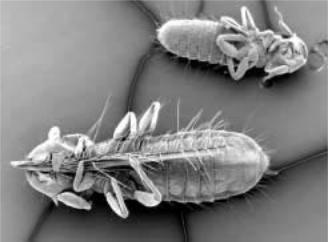
Vol. 3: Insects
Behavior
Observations on the behavior of lice are limited to generalizations obtained from a few louse species. Amblyceran lice typically are more mobile than the other louse suborders, and some species are known to make short forays away from the host. For the majority of species, however, remaining attached to the host is critical for survival, and lice have a variety of behavioral and morphological adaptations to ensure that they never become parted from their host, except during dispersal. Wing lice of birds escape preening by inserting between feather barbs of the wing feathers, and there is a strong correlation between the size of the interbarb space and the size of the lice for different host and louse species. Similarly, “fluff lice” that occupy the fine feathers close to the abdomen, escape the preening activity of their hosts by burrowing down into the downy basal regions of these feathers. Lice grip feather barbs or hair shafts with the aid of their tightly locking mandibles. Even when dead, the dried exoskeletons of lice can remain fixed firmly to the host’s body and frequently are recovered from museum collections of mammal and bird skins, long after the death and preservation of the host.
Successful transmission is perhaps the greatest challenge faced by any parasite, and lice are no exception. Direct physical contact between host individuals remains the principal route of dispersal for lice within a host species. Shared nest holes and nest material, predator-prey interactions, and mixed species use of dust baths all provide opportunities for dispersal to a new host species. Arguably the most unusual means of dispersal between hosts involves hitchhiking on the abdomen of hippoboscid flies, a phenomenon known as “phoresy.” Records of phoresy are relatively common for louse species belonging to the ischnoceran louse genera Degeeriella and Brueelia but are rare for other taxa, and this is unlikely to represent a major means of dispersal for most lice.
Feeding ecology and diet
Specializations in the diet of lice underpin their major taxonomic divisions. The Anoplura, or sucking lice, are the only group that feeds exclusively on mammalian blood, drawn up from small vessels located close to the surface of the host’s skin. Small buccal teeth are used to pierce the skin’s surface, and a bundle of sharp stylets are extruded from the haustellar sheath of the louse into the host. This flexible bundle can be driven in different directions until a suitable blood vessel is located. Once the tip of the bundle enters a vessel, feeding can commence. The other three louse suborders possess a pair of distinct mandibles.
Rhynchophthirina (elephant lice and their relatives) have mandibles located at the end of a long rostrum. They each have been rotated 180 degrees so that they articulate outward, rather than oppose each other. Thus, Rhynchophthirina cannot “bite” or “chew” in the traditional sense of the word, but instead they use the sharply serrated mandibles to rasp at the skin, allowing a pool of blood to form that is sucked up through an opening at the end of the rostrum. These are true pool feeders (telmophages), unlike the vessel-feeding Anoplura (solenophages).
Order: Phthiraptera
Scanning electron micrograph of two species of rhea louse (Archolipeurus nandu, bottom, and Struthiolipeurus stresemanni, top). The lower specimen is gripping a feather barbule between its legs and mandibles, illustrating a typical feeding and attachment behavior. (Image by Vince Smith. Reproduced by permission.)
All species of avian Ischnocera are believed to feed exclusively on feather barbules, the remains of which usually can be seen in crops of specimens that have fed recently. These are sheared from feathers by toothed mandibles. Mammalian Ischnocera (family Trichodectidae) feed on skin debris and hair (although this is disputed by some researchers), and at least one species is known to take blood meals. Amblycera have more generalist feeding habits, and in addition to feathers or hair, are known to feed on flakes of dead skin, blood, and skin secretions. Most chewing lice that do not partly blood-feed have an efficient water-vapor uptake system that extracts water from the atmosphere. For this reason, these species are particularly sensitive to the ambient humidity.
Reproductive biology
Lice are difficult to study under natural conditions, and for this reason most information on the bionomics of lice (i.e., their relations with other organisms and the environment) is obtained from in vitro studies, with the attendant disadvantages of applying laboratory results to natural situations. Separate male and female sexes are known for most louse species, but a few species reproduce parthogenetically. Lice eggs are attached to feather barbs; to hairs; or, in the case of the human body louse, to projecting clothing fibers with a drop of glandular cement. This surrounds the substrate and the base of the egg. Eggs, also known as nits, usually are attached close to the host’s skin and remain firmly fastened as the feather barb or hair grows outward. Typically whitish in color, the eggs require four to 10 days of incubation before hatching, depending upon species and ambient temperature. When the nymph is ready to hatch, air is drawn in though the mouth and accumulates behind the nymph. When sufficient pressure is reached, the caplike operculum on the noncemented end of the egg is forced open, and the first-stage nymph crawls out. Three nymphal stages follow, each lasting three to 12
Grzimek’s Animal Life Encyclopedia |
251 |
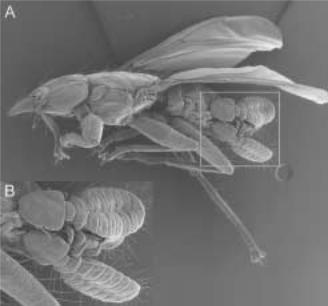
Order: Phthiraptera
A. Scanning micrograph of two lice (Brueelia sp.) riding on the abdomen of a hipposcid fly. B. Inset shows close up of the attachment site on the fly. This phoretic association may help distribute lice between hosts. (Image by Vince Smith. Reproduced by permission.)
days. In some cases the first-stage nymphs, while lacking functional genitalia, may be miniature versions of the adult; in others, the nymphs successively become more adultlike through each instar (developmental stage). Adult lice live for about one month, and a female human body louse may produce 50–150 eggs during her lifetime.
Conservation status
It is seldom appreciated that the extinction of a mammal or bird species also results in the extinction of all associated host-specific parasites. The extreme host specificity of lice, along with other ectoparasite groups, such as feather mites and fleas, leaves them particularly vulnerable to co-extinction.
Vol. 3: Insects
At least eight species of lice were known to be extinct by 1990, and this is almost certainly a gross underestimate of true loss of louse species diversity within the past century. Perhaps as the result of ignorance or the negative human perception of parasites, just one louse species (Haematopinus oliveri—an anopluran whose host species is the pygmy hog, Sus salvanius) is listed on the IUCN Red List of threatened species as of 2002, yet this same list defines 185 bird and 184 mammal species as Extinct in the Wild or Critically Endangered. If we assume that these species have an average rate of hostspecific louse infestation, there are at least 50 species of lice that face a significant and immediate threat of extinction within the next 10 years.
Significance to humans
The human body louse (Pediculus humanus “humanus”; quote marks are used to indicate that this is not considered a valid taxonomic species) is the principal vector for Rickettsia prowazekii, which causes louse-borne typhus; Bartonella quintana, which causes trench fever; and Borrelia recurrentis, which causes epidemic or louse-borne relapsing fever. Epidemic and endemic infections can occur in conditions that foster the prevalence of lice, such as among homeless populations, in refugee camps, and during times of war or natural disasters. Humans can be infested with the human head louse (Pediculus humanus “capitis”), which is confined to the scalp and is common among schoolchildren worldwide, or the pubic louse (Pthirus pubis), which normally is transmitted through sexual contact.
Lice are important pests of domesticated mammals and poultry, and while modern insecticides have proved highly effective at controlling louse infestations, concerns over the safety of these chemicals, insecticide resistance, and the difficulty of treating large numbers of animals on a regular basis mean that lice will continue to be a major problem for livestock farmers. In 1994, for example, lice cost the Australian sheep industry an estimated $100 million U.S. dollars through lost production and control costs. Similar losses are likely in other countries where sheep, cattle, or poultry are farmed intensively.
252 |
Grzimek’s Animal Life Encyclopedia |
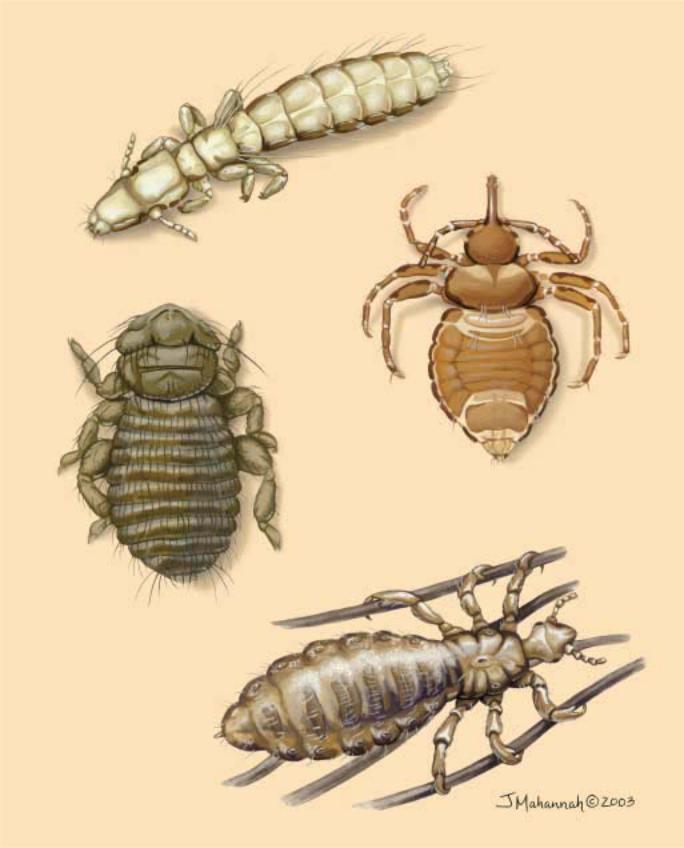
1
2
3
4
1. Slender pigeon louse (Columbicola columbae); 2. Elephant louse (Haematomyzus elephantis); 3. Wandering seabird louse (Ancistrona vagelli); 4. Human head/body louse (Pediculus humanus). (Illustration by Jacqueline Mahannah)
Grzimek’s Animal Life Encyclopedia |
253 |
